Newsletter: Coronavirus Today: Rethinking vaccine protection
- Share via
Good evening. I’m Karen Kaplan, and it’s Friday, Sept. 17. Here’s the latest on what’s happening with the coronavirus in California and beyond.
Friday was a complicated day for the Pfizer-BioNTech vaccine — and thus, for the more than 98 million fully vaccinated Americans who have taken it.
First, an advisory panel to the Food and Drug Administration recommended against making booster shots available to people 16 and older as long as eight months had passed since their second dose. The vote wasn’t even close — two in favor and 16 against.
The decision was a surprise, considering that President Biden had all but promised to roll out booster doses starting next week. (To be fair, he cautioned that boosters would be available only if the FDA agreed that they were safe and effective.)
Another endorsement had come from Dr. Anthony Fauci, Biden’s chief advisor on all things COVID-19. Fauci is one of the biggest booster backers in the U.S. Two days before the vote, he said a failure to endorse the shots “would be a mistake.”
That’s clearly not how the members of the FDA advisory panel saw it. Dr. Eric Rubin, a panel member and infectious disease expert at the Harvard T.H. Chan School of Public Health, said that if the agency were to approve booster shots for everyone 16 and up, it would pretty much redefine what it means to be considered fully vaccinated.
That would have complicated implications for the roughly 98 million Americans who have received two doses of the Pfizer vaccine.
“None of us are there yet,” Rubin said.
Their concerns were two-fold. On the risk side, they said the clinical trial to test the booster shots was too small to provide clear evidence that a third dose would be safe for everyone who would take it. And on the benefit side, they were not convinced that breakthrough infections were causing enough cases of serious disease and death to warrant a blanket booster approval.
Once the initial proposal was shot down, the panel members considered — and agreed to — more targeted recommendations for boosters, which are already available to people with weakened immune systems. Now three more groups can join that list: people who are 65 and older; people at risk of developing severe disease; and people, including healthcare workers, whose occupations put them at high risk of infection.
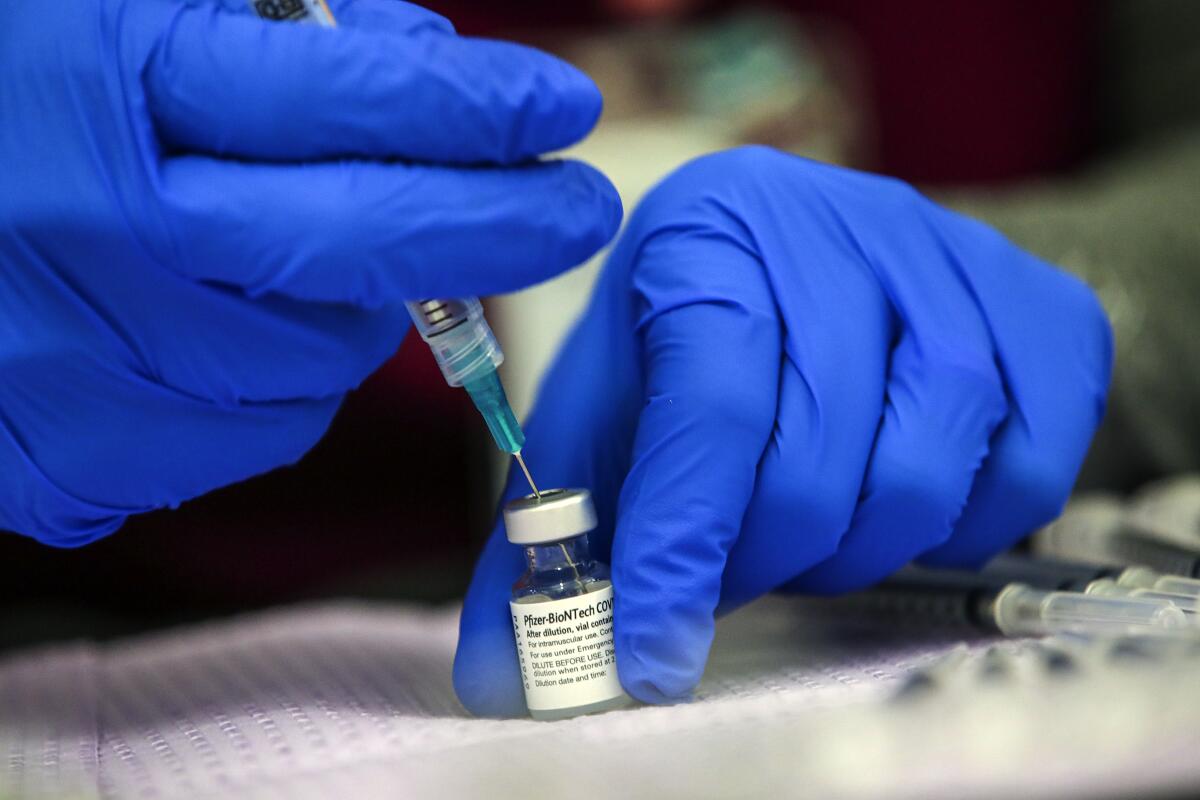
And that was only part of the Pfizer vaccine news. The other part came in the form of a report published by the Centers for Disease Control and Prevention.
Researchers from around the country collected data from 18 states and found striking differences between the Pfizer vaccine and its Moderna cousin. The two mRNA vaccines were long thought to be interchangeable.
The data showed that in the initial months after administration, both did an impressive job of preventing cases of COVID-19 that are serious enough to require hospital care. In the first 120 days, the Moderna vaccine was 93% effective at preventing COVID-19 hospitalizations, and the Pfizer vaccine was 91% effective.
But after 120 days, their records diverged. For Moderna, that measure of vaccine efficacy dipped only slightly, to 92%. For the Pfizer vaccine, it dropped to 77%.
That gap is concerning, considering that 54% of fully vaccinated Americans have been immunized with the Pfizer shot.
Scientists have some ideas about what might account for the difference. For instance, Moderna’s shot contains 100 micrograms of vaccine, compared with 30 for Pfizer. Also, the Moderna doses are given four weeks apart, versus three weeks for Pfizer.
Dr. Robert Murphy, who directs Northwestern University’s Institute for Global Health, said numbers in the report may bolster the case for boosters for all who got the Pfizer vaccine — not just the specific groups identified by the FDA advisory panel.
“Based on the data I have seen, persons who received the Pfizer vaccine would benefit from a booster dose at this time,” he said. “I don’t see why we have to wait until the younger people get sick and become hospitalized.”
By the numbers
California cases and deaths as of 7:45 p.m. Friday:

Track California’s coronavirus spread and vaccination efforts — including the latest numbers and how they break down — with our graphics.
L.A. street medicine
It can be hard to find silver linings to the pandemic, but there’s been a big one for unhoused people in Los Angeles County. Thanks to an infusion of COVID-19 relief funds, the Department of Health Services was able to launch a street medicine program.
Street medicine is just what it sounds like: healthcare providers making house calls to people who don’t have houses. It is practiced around the country, with more than two dozen programs across California. Some of those are in L.A. County, where more than 66,000 people live on the streets.
Despite the obvious and growing need, it took a global public health crisis to get the county health department in on the act. Now it sends teams of doctors, nurses, physician assistants and emergency medical technicians to homeless encampments to deliver all kinds of care.
They take vital signs. They clean and treat wounds. They hand out antibiotics and medicine to reverse drug overdoses. They connect ultrasound wands to smartphones and do prenatal checks. When they’re done, they leave behind plastic-wrapped meals.
A January 2021 report from the county health department said that the risk of premature death is nearly three times higher for an unsheltered person than for someone of the same age and gender who has a reliable place to live. There is plenty of work to do.
These days, getting people vaccinated against COVID-19 is an important part of the job. By the end of August, an estimated 38% of the county’s homeless population had gotten a shot.

My colleagues Emily Alpert Reyes and Francine Orr spent time with one of the health department’s dozen or so teams as they tended to patients along the concrete bed of La Canada Verde Creek in Santa Fe Springs.
The team vaccinated a handful of people, sometimes climbing the steep embankment to reach people living in tents or under tarps. One patient didn’t make a big deal out of getting the shot; another was eager to get his hands on some kind of record that would prove he was vaccinated.
That man, 60-year-old Barry Gadient, also asked team members about the latest coronavirus science. Why was it so important to wash hands if the virus spreads mainly via the air? Could his immune system be weakened by wearing a mask over his nose and mouth?
Daniel Newell, a vaccine logistics program manager with the health department, answered Gadient’s questions. The conversation went far more smoothly than a recent encounter in Lancaster, he said. He had been administering vaccinations to homeless people there when someone accosted him. “How does it feel to assassinate your fellow Americans?” the man had asked.
The county’s street medicine teams are funded through the end of the year. No one knows what will happen in 2022 — with the program or the pandemic.
Lawmakers in Sacramento passed a bill that would make it easier to keep the work going with Medi-Cal funding. It’s now up to Gov. Gavin Newsom to decide whether or not to sign it.
California’s vaccination progress
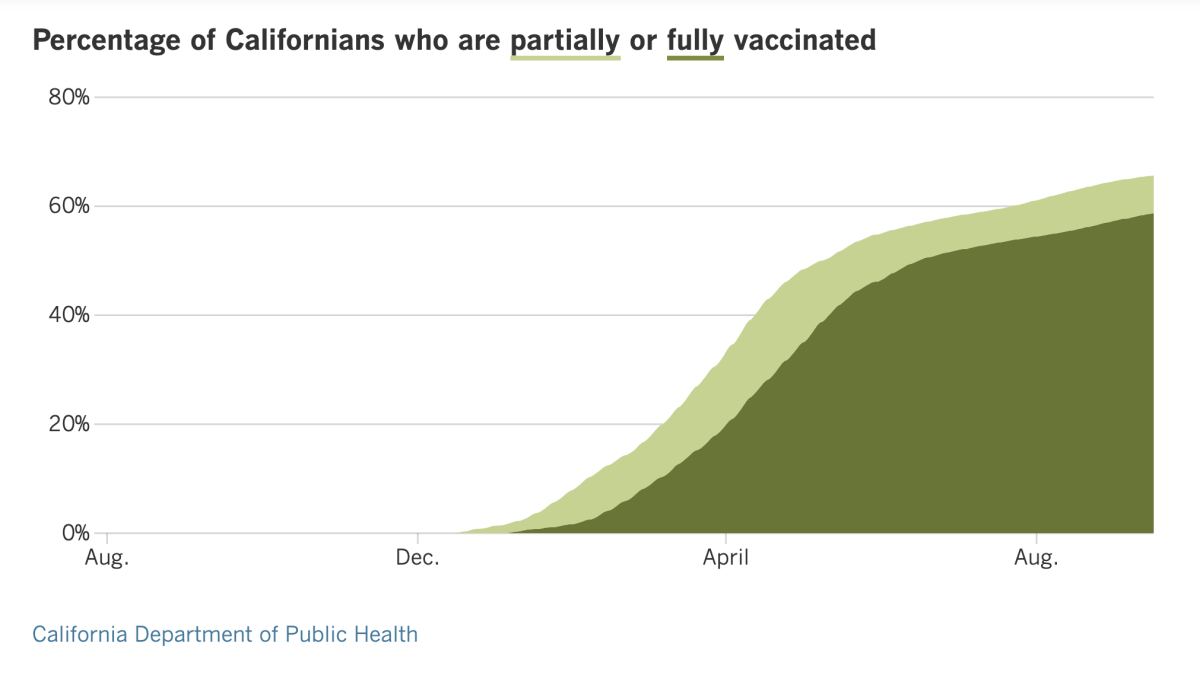
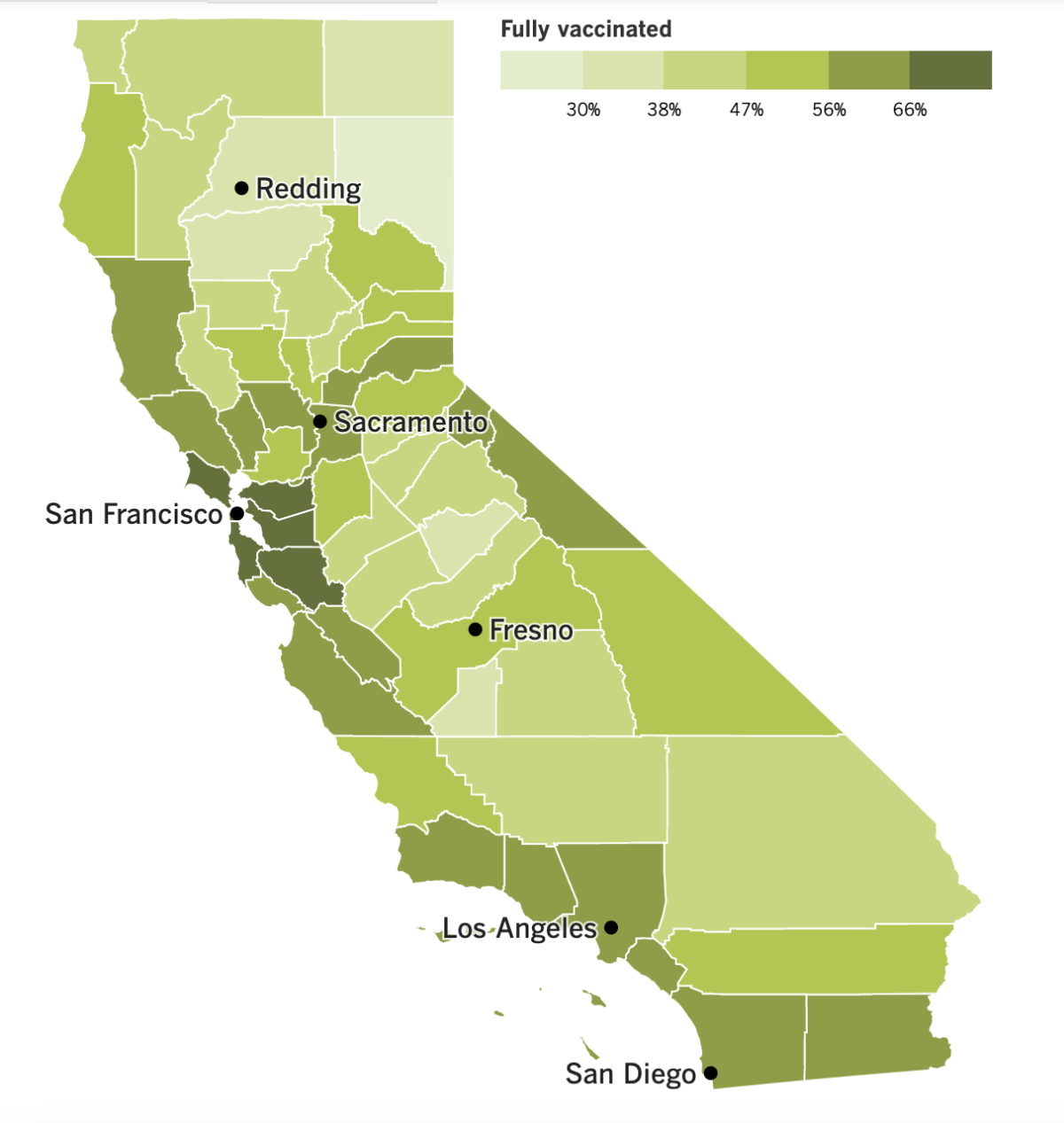
See the latest on California’s vaccination progress with our tracker.
Consider subscribing to the Los Angeles Times
Your support helps us deliver the news that matters most. Become a subscriber.
In other news ....
Los Angeles County is hoping to avoid a repeat of last year’s fall and winter with a new push to get people vaccinated. To that end, health officials this week announced a variety of vaccine requirements for entertainment and leisure venues.
The timing may seem odd, with coronavirus cases finally falling. Experts say the goal is to keep it that way.
“This is a reasonable path forward that will position us to be better able to break the cycle of surges,” said Los Angeles County Public Health Director Barbara Ferrer.
She anticipates that the holiday season will once again prompt people from all over to mix, including from places where coronavirus levels are higher than they are here. Colder weather will also cause people to spend more time together indoors, another factor that heightens the transmission risk.
So unless the pace of vaccination rises, the county is at risk of seeing a “cycle of repeated surges every few months,” Ferrer warned.
One of the few upsides of the Delta surge is that it has spurred some people to prioritize the shots. Weekly vaccinations rose in late July and early August, but that bump didn’t last.
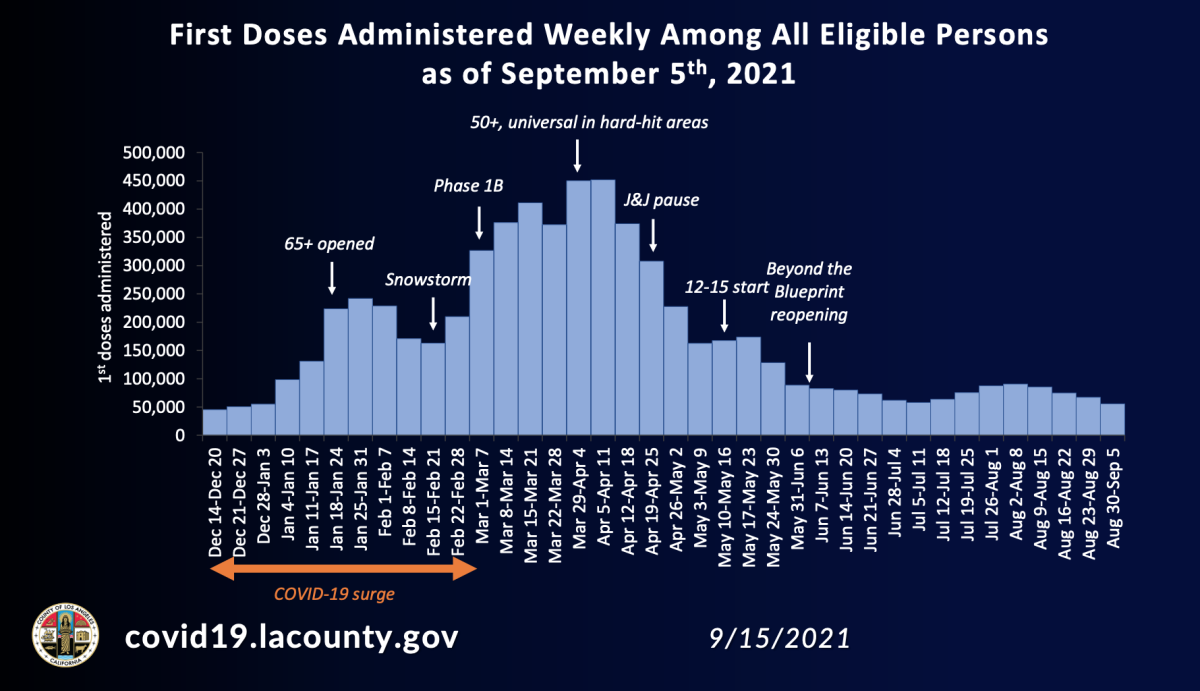
How much could vaccinations help? A model developed by USC estimates that if everyone in L.A. County had been vaccinated this summer, there would have been just 80 COVID-19 deaths here between June 1 and Sept. 1. In reality, there were 900. (In the absence of any vaccines, the death toll would have reached 13,000, the model suggests.)
Newsom echoed Ferrer’s view that it’s time to buckle down, not rest on our laurels.
It “was around this time last year we started to see that stabilization and decline as well,” the governor said. “Of course, the best way to mitigate that ... is to continue our vaccine efforts.”
It looks like L.A.-area schools are doing their part to keep the coronavirus in check. With roughly five weeks of in-person instruction in the books, the county’s schools have managed to avoid a troubling number of outbreaks.
What’s more, the beginning of the school year has coincided with a roughly 40% decline in pediatric coronavirus cases. Hospitalization rates for children are down as well.
Officials attributed the success in part to a statewide requirement that all K-12 students wear masks indoors. They point to Florida and Texas, where governors have attempted to prevent local districts from imposing such mandates. In those states, COVID-19 hospitalizations among children are setting new records.
The low number of outbreaks in L.A. County allowed health officials to loosen quarantine rules for unvaccinated students.
If such students are exposed to someone who tests positive for a coronavirus infection, districts won’t be required to send them home for at least seven days. Instead, under a so-called modified quarantine, those unvaccinated-and-exposed students can stay in the classroom under certain conditions.
Among them: They have to remain symptom-free, they have to wear masks outdoors as well as indoors, they have to get tested twice over the course of a week, they have to skip their extracurricular activities and they have to remain at home when they’re not in class.
Remember last year’s scandal involving Newsom and a dinner party at the Michelin-starred French Laundry that appeared to violate COVID-19 safety rules? San Francisco Mayor London Breed might need a reminder.
According to a report in the San Francisco Chronicle, the mayor was seen maskless at a nightclub despite a city requirement to wear face coverings in indoor public settings except when actively eating or drinking. Breed “had a table of drinks in front of her and was often holding one” and “spent the night dancing, singing along and posing for photographs without a face covering,” the Chronicle reported.
Nationally, a new study outlines another way the pandemic has been damaging to the nation’s kids. Childhood obesity rates have been climbing for decades, but weight gain accelerated last year — especially in those who were already obese.
Before the pandemic, children who were classified as having a healthy weight gained 3.4 pounds a year, on average. During the pandemic, that rose to 5.4 pounds. Meanwhile, the average annual weight gain for those who were moderately obese went from 6.5 to 12 pounds, and for severely obese children, it went from 8.8 to 14.6 pounds.
Dr. Alyson Goodman of the CDC, one of the study’s authors, said the results signal a “profound increase in weight gain for kids” and are “substantial and alarming.”
And because the coronavirus always finds a way to add insult to injury, consider this: Not only does does the pandemic appear to be fueling a rise in obesity, but obesity itself is a risk factor for severe COVID-19.
New Jersey, which was pummeled by the coronavirus at the start of the pandemic, no longer has the highest COVID-19 death rate in the United States. As of Thursday, that title belongs to Mississippi.
Roughly 1 in every 320 Mississippians has succumbed to the coronavirus. The state’s health officer, Dr. Thomas Dobbs, warned that the deaths aren’t over.
“We’re recording well over 2,500 [coronavirus cases] a day, in recent days, far more than we’d like to see,” he said. “A lot of that’s going to translate into the tragedy.”
Mississippi has one of the lowest vaccination rates in the country, with just 41.7% of the population fully vaccinated, according to the Mayo Clinic’s tracker. Only four states — Alabama, Idaho, Wyoming and West Virginia — are worse.
And in Austria, a civil trial opened Friday that blames the government for bungling a massive coronavirus outbreak at an Alpine ski resort in the pandemic’s early days, causing unnecessary infections and deaths.
The outbreak in the Paznaun valley was one of Europe’s first superspreader events. Among its victims was a 72-year-old Austrian man who died of COVID-19. His widow and son, Sieglinde and Ullrich Schopf, are suing the government for about 100,000 euros ($117,000) in compensation.
An independent commission has already determined that authorities were too slow to shut the ski resort after they realized they were dealing with a coronavirus outbreak. The case is seen as a test for a class-action suit involving hundreds of people who fell ill with COVID-19 following a trip to the area in February and March 2020.
“Stopping people from leaving and arriving in the Paznaun valley or at least issuing a travel warning — the authorities failed to do that,” said a lawyer representing the Schopfs. “Thousands of people left the Paznaun valley unhindered, thousands of people arrived without a clue that they were in danger.”
Your questions answered
Today’s question comes from readers who want to know: Do I need to be vaccinated to go to a bar in L.A. County?
Not yet. But proof of COVID-19 vaccination will soon be required to enter indoor bars, wineries, breweries, nightclubs and lounges throughout most of California’s most populous county.
Patrons and employees will need to show proof that they’ve had at least one dose of vaccine by Oct. 7 and that they’re fully vaccinated by Nov. 4. The new rule is part of a county’s health order issued Friday.
Residents can confirm their vaccination status by using digital records provided by either the county or the state, or by showing their vaccine card or a photograph of it.
The new vaccine requirement does not apply to restaurants, though health officials strongly advise eateries to limit their indoor service to customers who can provide proof of vaccination.
The order targets drinking establishments because county health inspectors have observed customers eschewing their masks when holding a drink, even if they weren’t actively taking a sip, said Barbara Ferrer, the county’s public health director.
“They’re walking around, and there’s a lot of dancing, there’s a lot of close contact with lots and lots of people,” Ferrer said. “In general, the bars are higher-risk settings than restaurants.”
Long Beach, which has its own public health department, said it would align its rules to match the county’s order. Pasadena, which also has its own health department, said it would review the new health order before deciding “how we’ll move forward.”
We want to hear from you. Email us your coronavirus questions, and we’ll do our best to answer them. Wondering if your question’s already been answered? Check out our archive here.
The pandemic in pictures
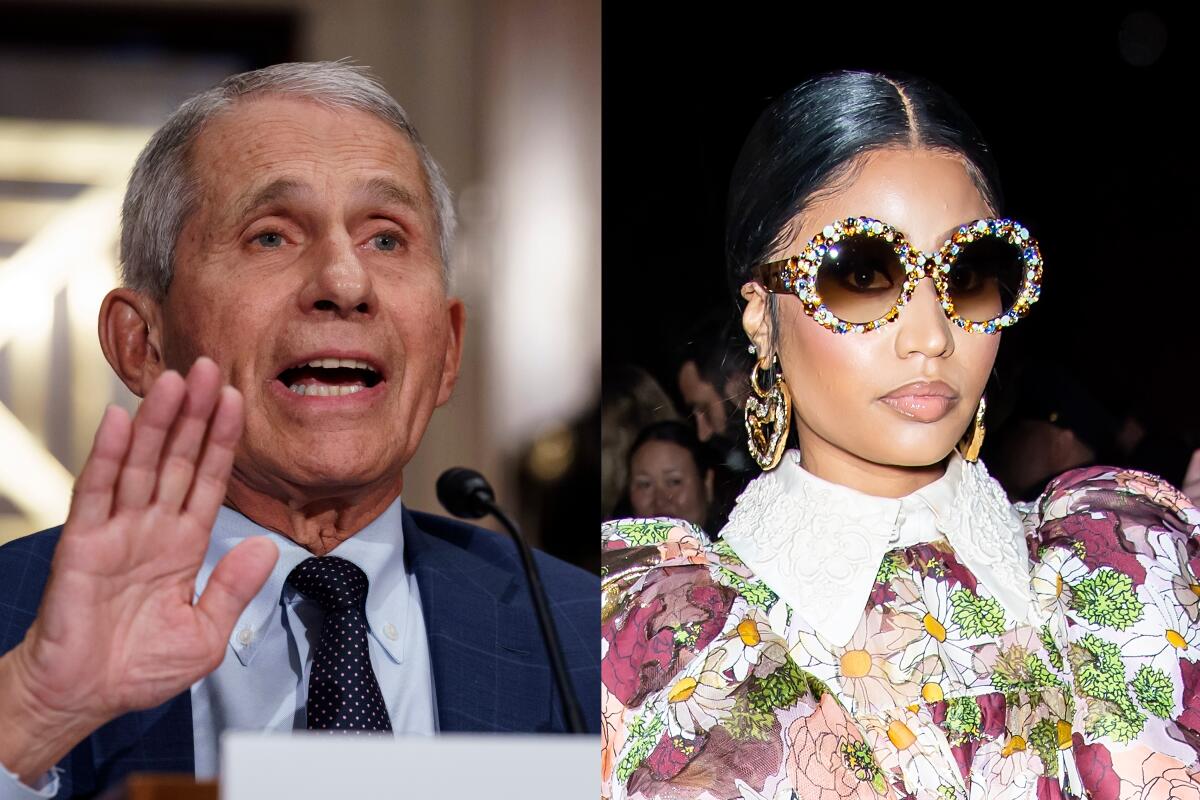
The composite photo above is something of an unexpected pairing. On the left is Dr. Anthony Fauci (if you’ve read this far, I don’t need to tell you who he is). On the right is Nicki Minaj, the multi-award-winning rapper/singer/songwriter.
Their worlds collided this week when Minaj started tweeting about COVID-19 vaccines. The issue came up because she hasn’t decided whether to get vaccinated, and her unvaxxed status prevented her from attending Monday’s glitzy Met Gala in New York City.
Nearly 2.5 billion people around the world are fully vaccinated, but Minaj tweeted that she is still doing her “research” — sparking some memorable discussion on Twitter.
Fauci weighed in to debunk some of Minaj’s more outlandish statements. (Long story short: COVID-19 vaccines do not affect the reproductive system.) “She should be thinking twice about propagating information that really has no basis,” Fauci told Jake Tapper on CNN.
Later, Minaj posted an Instagram Live video in which she said she was invited to the White House to speak with Fauci and Surgeon General Dr. Vivek Murthy. Press Secretary Jen Psaki disputed that, saying the Biden administration had only offered to hook Minaj up with “one of our doctors to answer questions she had about the safety and effectiveness of the vaccine.”
That’s not what Minaj heard. “Do y’all think I would go on the internet and lie about being invited to the f—ing White House?” she said in her 14-minute video. “Like what? Do you guys see what is happening right now?”
Minaj eventually allowed that she’d probably get vaccinated so she could go on tour.
Resources
Need a vaccine? Keep in mind that supplies are limited, and getting one can be a challenge. Sign up for email updates, check your eligibility and, if you’re eligible, make an appointment where you live: City of Los Angeles | Los Angeles County | Kern County | Orange County | Riverside County | San Bernardino County | San Diego County | San Luis Obispo County | Santa Barbara County | Ventura County
Practice social distancing using these tips, and wear a mask or two.
Watch for symptoms such as fever, cough, shortness of breath, chills, shaking with chills, muscle pain, headache, sore throat and loss of taste or smell. Here’s what to look for and when.
Need to get tested? Here’s where you can in L.A. County and around California.
Americans are hurting in many ways. We have advice for helping kids cope, resources for people experiencing domestic abuse and a newsletter to help you make ends meet.
We’ve answered hundreds of readers’ questions. Explore them in our archive here.
For our most up-to-date coverage, visit our homepage and our Health section, get our breaking news alerts, and follow us on Twitter and Instagram.




